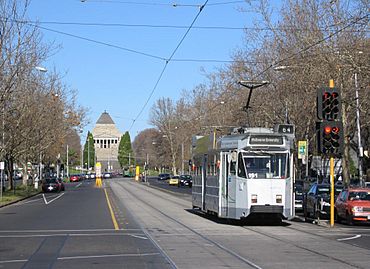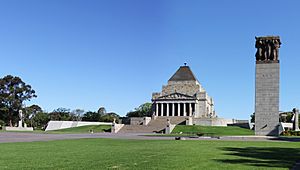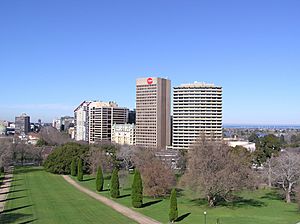St Kilda Road, Melbourne facts for kids
Quick facts for kids St Kilda RoadVictoria |
|
|---|---|
 |
|
| Looking away from the City towards the Shrine of Remembrance | |
| General information | |
| Type | Road |
| Length | 6 km (3.7 mi) |
| Route number(s) | |
| Major junctions | |
| Northwest end | Flinders Street, Melbourne |
|
|
| Southeast end | Brighton Road and Carlisle Street, St Kilda |
| Location(s) | |
| Major suburbs | Southbank, Melbourne 3004 |
St Kilda Road is a famous street in Melbourne, Victoria, Australia. It's a really important street in Melbourne, like a main backbone, especially with Swanston Street.
St Kilda Road starts at Flinders Street in the city center. It crosses Princes Bridge over the Yarra River, connecting the city to the suburb of St Kilda. The road ends at Carlisle Street in St Kilda. From there, it continues as Brighton Road and then the Nepean Highway. This long road helps connect the city to the bayside suburbs and the Mornington Peninsula.
The east side of St Kilda Road, up to High Street, Prahran, is part of the City of Melbourne. The west side and the road south of High Street are in the City of Port Phillip.
Contents
A Look Back: St Kilda Road's History
In the 1830s, the path leading south from Melbourne towards St Kilda was just a dirt track. People called it Baxter's Track, named after Melbourne's first postmaster, Captain Baxter.
In 1842, land in St Kilda was first sold. Soon, St Kilda became a popular spot for rich settlers. They loved the cool breezes from the beach during Melbourne's hot summers. The dirt track, which would become St Kilda Road, linked St Kilda to the town. But after rain, it turned into thick mud, making it impossible for carriages to pass.
Before the first bridge was built in 1844, people crossed the Yarra River using private boats called punts. In 1844, a wooden toll bridge was built over the river at Swanston Street.
In 1850, a new, free bridge made of sandstone, called Princes Bridge, replaced the wooden one. This bridge was designed by David Lennox. Its opening was a big event, with important people like Superintendent Charles La Trobe attending.
In 1853, the Immigrants' Aid Society opened a home on St Kilda Road. It cared for children who had no family or home. This home later became the site of the Melbourne Hospital in 1902. In 1854, the beautiful Kings Domain garden was created. That same year, the government offered land to religious groups to build schools. Wesley College started building in 1865 and opened in 1866. Melbourne Grammar School also got land and opened in 1858.
In the early 1850s, St Kilda Road was a bit dangerous. Armed robbers, known as bushrangers, often held people up. These events were called the St Kilda Road robberies. Victoria Barracks, a military base, was built between 1856 and 1872. By the 1860s, St Kilda was a popular holiday spot by the bay. St Kilda Road was planned to be a wide, European-style street, like a grand avenue, for horse-drawn carriages. Fawkner Park was created in 1862. In 1865, the Victorian College for the Deaf built its bluestone building on St Kilda Road.
The Alfred Hospital was built in 1871. From the 1870s, some of Melbourne's wealthiest families built huge, fancy houses along the street.
In 1877, a circus set up on the land where the Arts Centre is now. The current Princes Bridge was built in 1888, replacing the older one. At this time, cable trams started running along St Kilda Road. The beautiful elm trees that line the road today were planted then. Prince Henry's Hospital also opened on St Kilda Road in 1885.
Until the late 1800s, the Yarra River often flooded. So, from 1896 to 1900, a new, wider channel was dug for the river. The soil from this digging was used to fill swampy areas and raise the river banks. This is where Alexandra Gardens are now, which opened in 1901.
In 1901, the Arts Centre site became home to a permanent circus called Olympia. In 1904, part of the site became a fashionable meeting place called Prince's Court. It had a Japanese Tea House, an outdoor theater, and a miniature train. In 1907, Wirth Brother's Circus took over the site and stayed for 50 years. During World War I, some buildings were used as nursing homes for soldiers. In the 1920s, a new dance hall called the Green Mill replaced an older one.
In 1925, electric trams replaced the cable trams along St Kilda Road. Prince's Bridge was made stronger to handle the heavier new trams.
The Melbourne Hebrew Congregation opened a large synagogue on the corner of Toorak Road in 1930. During the 1930s, many of the grand mansions on St Kilda Road were divided into smaller apartments. This means only a few of them are left today. The Shrine of Remembrance was finished in September 1934. The Repatriation Commission Outpatient Clinic, a building with a unique Art Deco style, opened in 1937.
In the 1950s, people wanted to build more apartments in the area. In the 1960s, the area's rules changed to allow more office buildings. This helped create more space for Melbourne's growing financial businesses. The area was given the postcode 3004 and could use "Melbourne" in its address, making it feel like an extension of the city center. The Green Mill Dance Hall closed in 1950. The remaining circus buildings on the Arts Centre site were destroyed by fire in 1953. Much of the site became a car park before the National Gallery of Victoria started being built in the early 1960s. The gallery opened in 1968.
In the 1970s, the government bought much of the land around St Kilda Junction. They knocked down many buildings, including the famous Junction Hotel. This was done to make the street wider for more cars. What was once High Street was made wider and became part of St Kilda Road, extending it to Carlisle Street. An underpass was built to connect Queens Road to Dandenong Road.
Building the Arts Centre began in 1973. The complex opened in stages, with Hamer Hall opening in 1982 and the Theatres Building in 1984. The Southbank area along the Yarra River started to be redeveloped in 1990.
Since the 1980s, rules have been put in place to protect the few remaining old mansions. Height limits have also been set for new buildings to keep the street looking uniform.
On 13 February 2017, St Kilda Road was added to Australia’s National Heritage List. In June 2017, a small number of the elm trees along St Kilda Road were cut down for the Melbourne Metro Rail Tunnel project.
St Kilda Road Today
Today, St Kilda Road is a busy part of the city. It remains one of Melbourne's main roads, with many office buildings, apartments, and mixed-use towers along its sides.
The street is known for being wide and full of trees. For most of its length, it has a wide footpath lined with Elm trees, street parking, a bicycle lane, two lanes for cars, a grassy area in the middle with mature London Plane trees, another two lanes for cars, and a tram line on each side.
Melbourne's trams travel down the center of the road along its entire length.
There have been ideas to add a separate bike lane to the road.
Famous Places Along St Kilda Road

St Kilda Road passes by several of Melbourne's well-known parks, landmarks, and institutions. These include:
- Alexandra Gardens
- Arts Centre Melbourne
- National Gallery of Victoria
- Victorian College of the Arts
- Victoria Barracks
- Repatriation Commission Outpatient Clinic
- Shrine of Remembrance
- Domain Interchange
- Melbourne Grammar School
- The former Chevron Hotel, which is now an apartment complex.
- The historic bluestone building of the Victorian College for the Deaf and Deaf Children Australia.
- Wesley College - St. Kilda Road Campuses
- St Kilda Junction
Getting Around: Transport on St Kilda Road
Many tram routes run along St Kilda Road, including routes 1, 3, 5, 6, 16, 58, 64, 67, and 72. This makes it the busiest tram corridor in the world! A number of bus routes also use the road, connecting it well to the city and nearby suburbs.
Fun Events on St Kilda Road
Because St Kilda Road is so wide and centrally located, it's often used for many marches and events, such as:
- Southbank Sunday markets - held outside the Arts Centre.
- The 2006 Commonwealth Games opening ceremony.
- The Great Melbourne Bike Ride.
- Moomba - a large festival.
- The Anzac Day parade - which marches to the Shrine.
- The starting point for the AFL Grand Final Parade.




